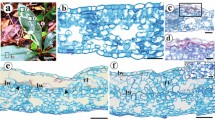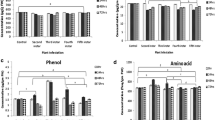Abstract
Induction of plant-derived chitinases in the leaves of a carnivorous plant was demonstrated using aseptically grown round-leaf sundew (Drosera rotundifolia L.). The presence of insect prey was mimicked by placing the chemical inducers gelatine, salicylic acid and crustacean chitin on leaves. In addition, mechanical stirring of tentacles was performed. Chitinase activity was markedly increased in leaf exudates upon application of notably chitin. Application of gelatine increased the proteolytic activity of leaf exudates, indicating that the reaction of sundew leaves depends on the molecular nature of the inducer applied. In situ hybridization of sundew leaves with a Drosera chitinase probe showed chitinase gene expression in different cell types of non-treated leaves, but not in the secretory cells of the glandular heads. Upon induction, chitinase mRNA was also present in the secretory cells of the sundew leaf. The combined results indicate that chitinase is likely to be involved in the decomposition of insect prey by carnivorous plants. This adds a novel role to the already broad function of chitinases in the plant kingdom and may contribute to our understanding of the molecular mechanisms behind the ecological success of carnivorous plants in nutritionally poor environments.



Similar content being viewed by others
Abbreviations
- ID:
-
Integrated density
- SA:
-
Salicylic acid
References
Adamec L (1997) Mineral nutrition of carnivorous plants: a review. Bot Rev 63:273–299
Amagase S, Mori M, Nakayama S (1972) Digestive enzymes in insectivorous plants. IV. Enzymatic digestion of insects by Nepenthes secretion and Drosera peltata extract: proteolytic and chitinolytic activities. J Biochem 72:765–767
Békésiová I (2000) Genes for proteins with antifungal activity in Drosera rotundifolia L. Ph.D. Thesis, Institute of Plant Genetics and Biotechnology, Slovak Academy of Sciences, Nitra, pp 1–147
Bobák M, Blehová A, Krištín J, Ovečka M, Šamaj J (1995) Direct plant regeneration from leaf explants of Drosera rotundifolia cultured in vitro. Plant Cell Tiss Org Cult 43:43–49
Bohak Z (1970) Chicken pepsinogen and chicken pepsin. Meth Enzymol 19:347–358
Bradford MM (1976) A rapid and sensitive method for the quantitation of microgram quantities of protein utilizing the principle of protein-dye binding. Anal Biochem 72:248–254
Broglie R, Broglie K (1993) Chitinases and plant protection. In: Fritig B, Legrand M (eds) Mechanisms of plant defense responses. Kluwer, Dordrecht, pp 411–421
Chandler GE, Anderson JW (1976) Studies on the origin of some hydrolytic enzymes associated with the leaves and tentacles of Drosera species and their role in heterotrophic nutrition. New Phytol 77:51–62
Clancy FG, Coffey MD (1977) Acid phosphatase and protease release by the insectivorous plant Drosera rotundifolia. Can J Bot 55:480–488
Cox KH, Goldberg RB (1988) Analysis of plant gene expression. In: Shaw CH (ed), Plant molecular biology, a practical approach. IRL Press, Oxford, pp 1–34
Culham A, Gornall RJ (1994) The taxonomic significance of naphthoquinones in the Droseraceae. Biochem Syst Ecol 22:507–515
Darwin C (1875) Insectivorous Plants. John Murray, London
Darwin F (1878) Experiments on the nutrition of Drosera rotundifolia. J Linn Soc Bot 17:17–27
Dixon KW, Pate JS, Bailey WJ (1980) Nitrogen nutrition of the tuberous sundew Dionaea erythrorhiza Lindl. with special reference to the catch of arthropod fauna by its glandular leaves. Aust J Bot 28:283–297
Ellison AM, Gotelli NJ (2001) Evolutionary ecology of carnivorous plants. Trends Ecol Evol 16:623–628
Gallie DR, Chang SC (1997) Signal transduction in the carnivorous plant Sarracenia purpurea. Plant Physiol 115:1461–1471
Gooday GW (1999) Aggressive and defensive role of chitinases. In: Jolles P, Muzzarelli RAA (eds) Chitin and chitinases. Birkhäuser Verlag, Basel, pp 157–171
Heslop-Harrison Y (1975) Enzyme release in carnivorous plants. In: Dingle JT, Dean RT (eds) Lysosomes in biology and pathology. North-Holland, Amsterdam, pp 525–578
Heslop-Harrison Y, Heslop-Harrison J (1981) The digestive glands of Pinguicula: Structure and cytochemistry. Ann Bot 47:293–319
Inbar J, Chet I (1991) Detection of chitinolytic activity in the rhizoshepore using image analysis. Soil Biol Biochem 23:239–242
Juniper BE (1989) The path to plant carnivory. In: Juniper BE, Southwood TRE (eds) Insects and the plant surface. Edward Arnold, London, pp 195–218
Juniper BE, Robins RJ, Joel DM (1989) The carnivorous plants. Academic Press, London, pp 1–392
Kasprzewska A (2003) Plant chitinases - regulation and function. Cell Mol Biol Lett 8:809–824
Laemmli UK (1970) Cleavage of structural proteins during the assembly of the head of bacteriophage T4. Nature 227:680–685
Lichtner FT, Williams SE (1977) Prey capture and factors controlling trap narrowing in Dionaea (Droseraceae). Am J Bot 64:881–886
Linthorst HJM (1991) Pathogenesis-related proteins of plants. Crit Rev Plant Sci 10:123–150
Melchers LS, Stuiver MH (2000) Novel genes for disease-resistance breeding. Curr Opin Plant Biotech 3:147–152
Millett J, Jones RI, Waldron S (2003) The contribution of insect prey to the total nitrogen content of sundew (Drosera spp.) determined in situ by stable isotope analysis. New Phytol 158:669–675
Molano J, Duran A, Cabib E (1977) A rapid and sensitive assay for chitinase using tritiated chitin. Anal Biochem 83:648–656
Muravnik LE, Ivanova AN (1999) Localization of Ca2+ and Ca2+-ATPase in the secretory cells of glandular hairs in Drosera leaves. Tsitologiya 41:386–393
Pan QS, Ye SX, Kuć J (1991) A technique for detection of chitinase, β-1,3-glucanase, and protein patterns after a single separation using polyacrylamide gel electrophoresis or isoelectrofocusing. Phytopathology 81:970–974
Robins RJ (1976) The nature of the stimuli causing digestive juice secretion in Dionaea muscipula Ellis (Venus’s flytrap). Planta 128:263–265
Robins RJ, Juniper BE (1980) The secretory cycle of Dionaea muscipula Ellis. IV. The enzymology of the secretion. New Phytol 86:413–422
Sambrook J, Fritsch EF, Maniatis T (1989) Molecular cloning: a laboratory manual, 2nd edn. Cold Spring Harbor Laboratory Press, Cold Spring Harbor, New York
Schulze W, Schulze ED, Pate JS, Gillison AN (1997) The nitrogen supply from soils and insects during growth of the pitcher plants Nepenthes mirabilis, Cephalotus follicularis and Darlingtonia californica. Oecologia 112:464–471
Sirova D, Adamec L, Vrba J (2003) Enzymatic activities in traps of four aquatic species of the carnivorous genus Utricularia. New Phytol 159:669–675
Stewart CN, Nielsen ET (1992) Drosera rotundifolia growth and nutrition in a natural population with special reference to the significance of insectivory. Can J Bot 70:1409–1416
Thum M (1989) The significance of carnivory for the fitness of Drosera in its natural habitat: 2. The amount of captured prey and its effect on Drosera intermedia and Drosera rotundifolia. Oecologia 81:401–411
Trudel J, Asselin A (1989) Detection of chitinase activity after polyacrylamide gel electrophoresis. Anal Biochem 178:362–366
Acknowledgements
This work was supported by INCO-Copernicus project IC15-CT96-0921, grant 2/5034/25 from the Slovak Grant Agency VEGA, APVT grant No. 51-005602 and a visitor grant from the Dutch Organisation for Scientific Research (NWO; LM).
Author information
Authors and Affiliations
Corresponding author
Rights and permissions
About this article
Cite this article
Matušíková, I., Salaj, J., Moravčíková, J. et al. Tentacles of in vitro-grown round-leaf sundew (Drosera rotundifoliaL.) show induction of chitinase activity upon mimicking the presence of prey. Planta 222, 1020–1027 (2005). https://doi.org/10.1007/s00425-005-0047-5
Received:
Accepted:
Published:
Issue Date:
DOI: https://doi.org/10.1007/s00425-005-0047-5




